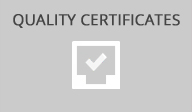Reaction Classes / Test Methods
Euroclasses (European Classes)
There are seven classes for reaction to the fire: Aca , B1ca , B2ca , Cca , Dca , Eca and Fca
If we summarize this table briefly and evaluate it according to the general usage pattern:
• Aca class cables are limited by the heat that will form the burnout,
• The classes B1ca , B2ca , Cca and Dca have various classes of types of cables that reduce fire risks (heat dissipation, flame spreading speed, smoke density, dripping characteristics during combustion and corrosive gas formation),
• The cables entering Eca class are classified according to the flame propagation on a single cable,
• We have come to the conclusion that no fire performance is required in Fca classes.
Reaction to Fire Classification and Test Methods (EN 50575)

Aca Class
According to EN ISO 1716 standard, should be the combustion result PCS ≤ 2 MJ/kg, except for the metals in the cable.
B1ca Class
a) According to EN 60332-1-2 standard, the flame should not spread to a distance of 425 mm after the test flame is turned off.
b) According to EN 50399 standard for a 30 kW flame source, values should be below:
FS ≤ 1,75 m
THR1200S ≤ 10 MJ
Peak HRR ≤ 20 kW
FIGRA ≤ 120 Ws-1
B2ca Class
a) According to EN 60332-1-2 standard, the flame should not spread to a distance of 425 mm after the test flame is turned off.
b) According to EN 50399 standard for a 20,5 kW flame source, values should be below:
FS ≤ 1,5 m
THR1200S ≤ 15 MJ
Peak HRR ≤ 30 kW
FIGRA ≤ 150 Ws-1
Cca Class
a) According to EN 60332-1-2 standard, the flame should not spread to a distance of 425 mm after the test flame is turned off.
b) According to EN 50399 standard for a 20,5 kW flame source, values should be below:
FS ≤ 2 m
THR1200S ≤ 30 MJ
Peak HRR ≤ 60 kW
FIGRA ≤ 300 Ws-1
Dca Class
a) According to EN 60332-1-2 standard, the flame should not spread to a distance of 425 mm after the test flame is turned off.
b) According to EN 50399 standard for a 20,5 kW flame source, values should be below:
THR1200S ≤ 70 MJ
Peak HRR ≤ 400 kW
FIGRA ≤ 1300 Ws-1
Eca Class
According to EN 60332-1-2 standard, the flame should not spread to a distance of 425 mm after the test flame is turned off.
Fca Class
Cables that do not have any fire performance rating or that do not pass the EN 60332-1-2 standard flame spread test.
In addition to these 7 main classifications, some additional criteria are also defined.
Smoke Production: s1, s1a, s1b, s2, s3 - s1 represents the best performance and s3 represents the lowest.
s1 = TSP1200s ≤ 50 m2 and the highest SPR ≤ 0.25 m2/s
According to EN 61034-2 ≥ 80%, s1a = s1 and permeability
According to EN 61034-2 ≥ 80%, s1b = s1 and permeability
s2 = TSP1200s ≤ 400 m2 and the highest SPR ≤ 1,5 m2/s
s3 = s1 or not s2
Flame Particles: d0, d1 , d2 - d0 represent the best performance and d2 represents the lowest.
d0 = No flaming droplets / particles in 1200 s
d1 = No flaming droplets / particles present in more than 10 s in 1200 s
d2 = d0 or not d1
Acidity: a1, a2, a3-a1 represent the best performance and a3 represent the lowest.
a1 = Conductivity < 2,5 µS/mm and pH > 4.3
a2 = Conductivity < 10 µS/mm and pH > 4.3
a3 = a1 or not a2
No Explanation = No Performance Detected
















